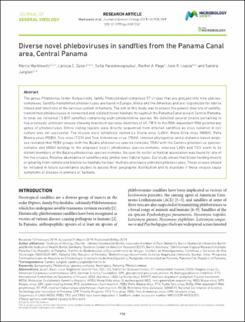| dc.contributor.author | Marklewitz, Marco | |
| dc.contributor.author | Dutari, Larissa C. | |
| dc.contributor.author | Paraskevopoulou, Sofia | |
| dc.contributor.author | Loaiza, Jose R. | |
| dc.contributor.author | Junglen, Sandra | |
| dc.date.accessioned | 2020-07-01T05:21:38Z | |
| dc.date.available | 2020-07-01T05:21:38Z | |
| dc.date.issued | 2019-05-03 | |
| dc.identifier.other | https://doi.org/10.1099/jgv.0.001260 | |
| dc.identifier.uri | http://repositorio-indicasat.org.pa/handle/123456789/149 | |
| dc.description | The genus Phlebovirus (order Bunyavirales, family Phenuiviridae) comprises 57 viruses that are grouped into nine speciescomplexes. Sandfly-transmitted phleboviruses are found in Europe, Africa and the Americas and are responsible for febrile illness and infections of the nervous system in humans. The aim of this study was to assess the genetic diversity of sandflytransmitted phleboviruses in connected and isolated forest habitats throughout the Panama Canal area in Central Panama. In total, we collected 13 807 sandflies comprising eight phlebotomine species. We detected several strains pertaining to five previously unknown viruses showing maximum pairwise identities of 45–78 % to the RNA-dependent RNA polymerase genes of phleboviruses. Entire coding regions were directly sequenced from infected sandflies as virus isolation in cell culture was not successful. The viruses were tentatively named La Gloria virus (LAGV), Mona Grita virus (MOGV), Peña Blanca virus (PEBV), Tico virus (TICV) and Tres Almendras virus (TRAV). Inferred phylogenies and p-distance-based analyses revealed that PEBV groups with the Bujaru phlebovirus species-complex, TRAV with the Candiru phlebovirus speciescomplex and MOGV belongs to the proposed Icoarci phlebovirus species-complex, whereas LAGV and TICV seem to be distant members of the Bujaru phlebovirus species-complex. No specific vector or habitat association was found for any of the five viruses. Relative abundance of sandflies was similar over habitat types. Our study shows that blood-feeding insects originating from remote and biodiverse habitats harbour multiple previously unknown phleboviruses. These viruses should be included in future surveillance studies to assess their geographic distribution and to elucidate if these viruses cause symptoms of disease in animals or humans. | en_US |
| dc.description.abstract | The genus Phlebovirus (order Bunyavirales, family Phenuiviridae) comprises 57 viruses that are grouped into nine speciescomplexes. Sandfly-transmitted phleboviruses are found in Europe, Africa and the Americas and are responsible for febrile illness and infections of the nervous system in humans. The aim of this study was to assess the genetic diversity of sandflytransmitted phleboviruses in connected and isolated forest habitats throughout the Panama Canal area in Central Panama. In total, we collected 13 807 sandflies comprising eight phlebotomine species. We detected several strains pertaining to five previously unknown viruses showing maximum pairwise identities of 45–78 % to the RNA-dependent RNA polymerase genes of phleboviruses. Entire coding regions were directly sequenced from infected sandflies as virus isolation in cell culture was not successful. The viruses were tentatively named La Gloria virus (LAGV), Mona Grita virus (MOGV), Peña Blanca virus (PEBV), Tico virus (TICV) and Tres Almendras virus (TRAV). Inferred phylogenies and p-distance-based analyses revealed that PEBV groups with the Bujaru phlebovirus species-complex, TRAV with the Candiru phlebovirus speciescomplex and MOGV belongs to the proposed Icoarci phlebovirus species-complex, whereas LAGV and TICV seem to be distant members of the Bujaru phlebovirus species-complex. No specific vector or habitat association was found for any of the five viruses. Relative abundance of sandflies was similar over habitat types. Our study shows that blood-feeding insects originating from remote and biodiverse habitats harbour multiple previously unknown phleboviruses. These viruses should be included in future surveillance studies to assess their geographic distribution and to elucidate if these viruses cause symptoms of disease in animals or humans. | en_US |
| dc.language.iso | eng | en_US |
| dc.rights | info:eu-repo/semantics/openAccess | |
| dc.rights | https://creativecommons.org/licenses/by-nc-sa/4.0/ | |
| dc.subject | Bunyavirales | en_US |
| dc.subject | Phlebovirus | en_US |
| dc.subject | species-complex | en_US |
| dc.subject | Neotropics | en_US |
| dc.subject | Panama | en_US |
| dc.subject | Phlebotominae | en_US |
| dc.title | Diverse novel phleboviruses in sandflies from the Panama Canal area, Central Panama | en_US |
| dc.type | info:eu-repo/semantics/article | en_US |
| dc.type | info:eu-repo/semantics/publishedVersion | |

